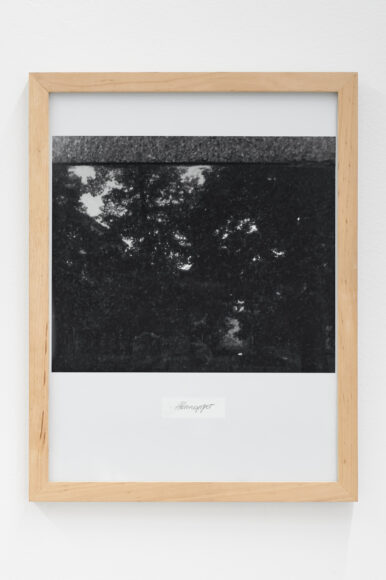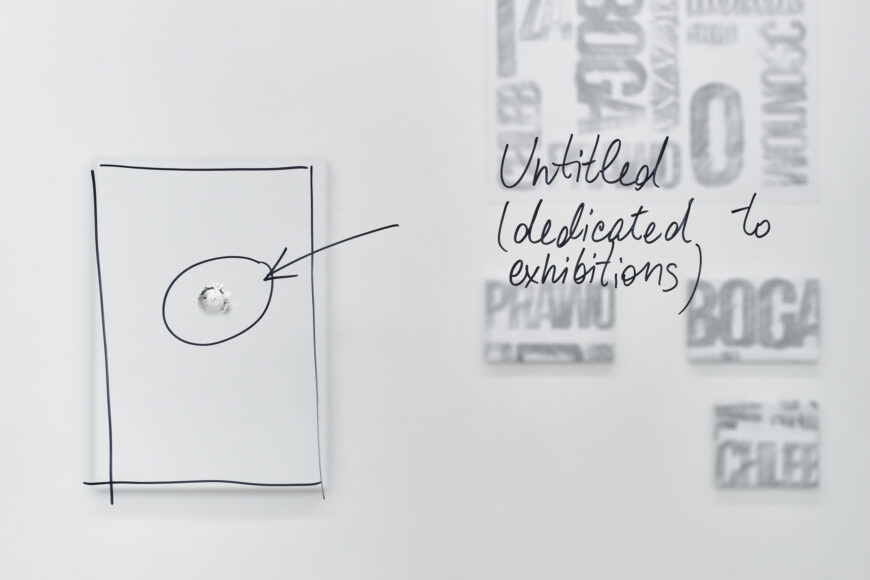Lada NakonechnaBodies in the Distance 4.12.2020—1.2.2021
Exhibition is currently available to view through front windows and online during the sanitary regime related to the Covid-19 pandemic.
Lada Nakonechna is the creator of drawings, photographs, installations, and performative actions. The artist’s work is deeply immersed in the politics of vision. Nakonechna is a careful observer of visual messages present in public space. Her works refer not only to current events in Ukraine, but also provide insightful analyses of the relations of power, violence, and alienation in contemporary European societies.
The Bodies in the Distance exhibition at the :SKALA gallery consists of works made by the artist since 2014, including the most recent ones created during her residency in Poznań. The title of the exhibition refers not only to the social condition during the so-called sanitary regime related to the Covid-19 pandemic — it also explores the atomization and disintegration of social relations under the pressure of the dominant discourses of power.
The installation Negotiating table from 2014 is dedicated to the victims of the protests of 2013–2014. In a succinct, bitterly ironic gesture, the artist placed photos of beaten demonstrators on a table in places that should be occupied by the sides of political negotiations. Created in 2015, a series of pencil drawings entitled War in Ukraine is a conceptual analysis of the language used to describe the armed conflict in Donbass. Each of the drawings offers a threefold interpretation of the same phrase, showing that the structure of language depends on our political position. The video work Switch on red from 2016 is a minimalistic performance to the camera showing the relativity of symbols that define political and cultural identity. The red flag presented at the beginning of the project changes colors thanks to the filters used. However, it is not the matter of the banner that changes, but its perception — depending on how certain visual parameters are set.
The exhibition also features the artist’s works made during her residency in Poznań. The installation Photozone consists of prints transferred directly onto the gallery wall. They multiply the word “God”, which was added to the monuments in Poznań and Białystok after the transformation in 1989 in order to improve or change their meaning. The point was to make them fit better with the requirements of the new official historical narrative. The work Package deals with the same topic. It is comprised of packages hung on the wall with patterns reproducing the inscriptions from the Monument to the Victims of June 1956 in Poznań and the Monument to the Heroes of Białystok Land in Białystok. The words: HONOR, GOD, LAW, BREAD, and HOMELAND, which appear taken out of context on the wrappers, have been repeated so many times that they have almost completely lost their meaning and are worth less than the paper on which they were printed. A critical analysis of monuments, which are carriers of the official historical policy in Poland, seems to be an important path for interpreting the exhibition. The same topic is also addressed in a small work entitled In foliage and in stone (self-portrait). This photo was taken in front of the Monument to the Polish Underground State in Poznań. You can only see the leaves and the light reflecting from the polished stone slab. The face of the author of the self-portrait is completely invisible. Two drawings The search of a “proper” sign for the monument to the Polish protests is a record of media texts about women’s protests against the Constitutional Court’s decision to enact stricter anti-abortion laws. The artist was in Poland during the culmination of the Women’s Strike demonstrations and made an attempt to create a description of a hypothetical monument dedicated to these events. The installation Untitled (dedicated to exhibitions) is a site-specific work using the unique features of the space of the SKALA gallery. The artist noticed a small hole in the windowpane — on the opposite wall, she placed a pierced object, which consists of pressed posters for exhibitions at the Arsenał Municipal Gallery in Poznań. The opening in the object is directly opposite the hole in the pane. When we look into the cavity hollowed out in the layers of the posters, we can see the hidden layers of prints revealing themselves to us, similarly to a geological open pit. This way, the artist comments on the accumulating effort of yet another art show, yet another artwork hung on the walls, which create a thicker layer, through which it is increasingly more difficult to break through.
At the exhibition in the SKALA gallery, Lada Nakonechna pays special attention to words as a vehicle for empty, hypocritical, blurred, and deceptive meanings; words whose content is rapidly eroding in the field of media and politics. The artist, on the other hand, appreciates the significance of words, giving her works very precise titles, which each time are an important part of the message.
The minimalist, conceptual form of these creations identifies precisely where the conflicts of meanings occur. Lada Nakonechna’s art is a multidimensional critical practice that exposes the official historical, economic, and symbolic discourses, which at all times, are an emanation of political and linguistic violence and oppression.
At the same time, the artist signals that she is aware of the aesthetic and cultural context that comprises the codes, with which she can communicate with her viewers. Her actions are aimed at retrieving social consciousness and creating alternative narrations, which will aid the process of political and cultural emancipation.
Marek Wasilewski
Lada Nakonechna (born in 1981 in Dnepropetrovsk) studied at the National Academy of Fine Arts and Architecture in Kiev. The artist has been the winner of the Pinchuk Art Center Prize (2013) and the Kazimir Malevich Art Award, funded by the Polish Institute in Kiev (2014). She has participated in numerous exhibitions in Ukraine and abroad. In 2011, she carried out a public space project in Leipzig — a mural at the “Albertina” University Library. She has organized an individual exhibition Weekdays at {Bank Pekao Project Room} at Ujazdowski Castle Centre for Contemporary Art (2012), and — together with Zahanna Kadyrova — she has prepared the exhibition Experiments at BWA Warsaw (2016). Her works have also been shown at Національний художній музей України, National Art Museum of Ukraine (Kiev, 2012, 2017), Museum of Modern Art in Warsaw (Poland, 2015), Kunsthall Trondheim (Norway, 2015), Galerie für Zeitgenössische Kunst, Leipzig (Germany, 2015), Palais Populaire, Berlin (Germany, 2018), and Museum of Contemporary Art, Zagreb (Croatia, 2018).
Since 2005, she has also cooperated with the R.E.P. group (Revolutionary Experimental Space). She is the co-founder of the Hudrada curatorial collective and The Method Fund (2015), as well as the editor of Prostory.net.ua ľ — an online magazine on literature, art, and politics. In 2019, she participated in the collective exhibition Tale of Novorossiya at the Arsenał Municipal Gallery in Poznań.
Lada Nakonechna is the first recipient of the Association Wielka 19 scholarship in Poznań for visual artists from the states of the former Soviet Union.













